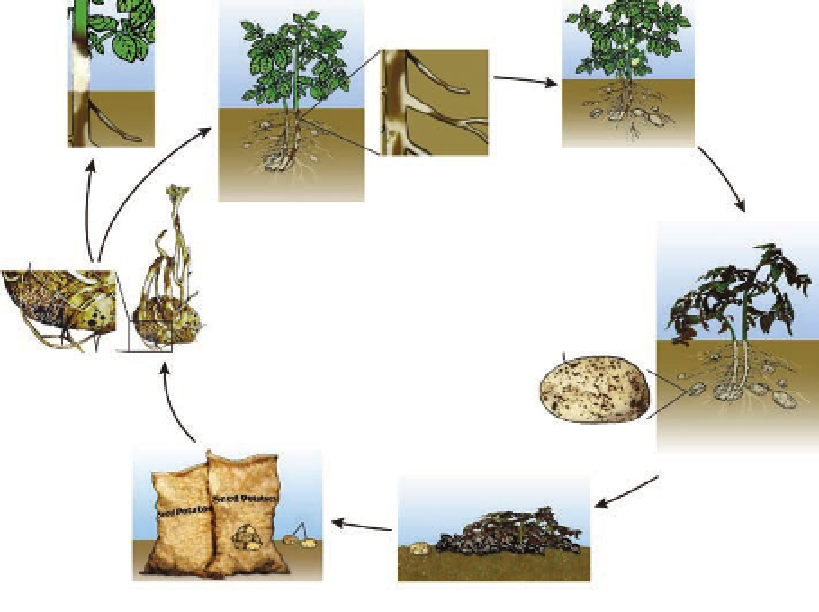Agriculture Reference
In-Depth Information
11.2 The Role of the Tuber
in Potato Disease
initiate new epidemics of potato late blight
(Doster
et al
., 1989; Stevenson
et al
., 2007; Olan-
ya
et al
., 2009). The epidemiology of the foliar
phase of the disease is correlated to infection in
the tuber phase and vice versa (Fairclough
et al
.,
1997; Cooke
et al
., 2011). Tubers are usually in-
fected by inoculum produced on the plant foliage
that is subsequently washed down to the soil by
water movement resulting from rainfall and irri-
gation (Andrivon, 1995; Porter
et al
., 2005).
Tubers can become blighted shortly after the
disease is established on the foliage.
P. infestans
survives in tubers, where it acts as the primary
source of inoculum for infection in the following
growing season (Bonde and Schultz, 1943). The
transmission of potato late blight from infected
seed tubers into developing sprouts and conse-
quently to the foliage was first suggested by
Berkeley (1846), and was demonstrated by Appel
et al.
(2001) using molecular techniques.
The pathway by which
P. infestans
progresses
from infected tubers to the newly formed plant is
not fully understood, but a current understanding
Infection and transmission of many potato dis-
eases, including late blight of potato caused by
the oomycete
P. infestans
(Mont. De Bary), and
the soilborne diseases Fusarium dry rot and
Rhizoctonia stem and stolon canker, are depend-
ent on survival in or on potato tubers. An example
of a common disease cycle, that of Rhizoctonia
stem and stolon canker, is shown in
Fig. 11.1
to
illustrate the role of the tuber in the disease cycle.
Most diseases have at least a transitory tuber
phase, and for many diseases, such as pink rot
(
Phytophthora erythroseptica
) (Venkataramana
et al
., 2010; Taylor
et al
., 2011), the major effect
is on the tuber. Tuber late blight (
P. infestans
) re-
sults in tuber rotting, both in the field and later in
storage, in tubers either intended for seed or for
consumption (Bonde and Schultz, 1943; John-
son and Cummings, 2009; Johnson, 2010). Seed
tubers infected with
P. infestans
will either rot in
storage after planting in the field or survive and
Early in season,
white mycelium often
develops on plant
parts in close
contact with soil.
This is the sexual
stage of the fungus.
Its role in the disease
is not well known.
When oberved,stem
lesions are often
severe.
SUMMER
Lesions on
stems and
stolon
LATE SUMMER/
FALL
Late-season damage may
result in formation of
aerial tubers.
Roots and stolons may be
attacked any time during
the growing season.
Mycelia
Mycelia and sclerotia on
infected tubers infect
developing sprout, root
and stolon primordia,
often nipping off
growing tips.
Rhizoctonia solani
disease cycle
Sclerotium
Sclerotia
SPRING
Sclerotia start to form on
tubers when still attached
to mother plant, and this
continues into storage.
Volunteer
potatoes
FALL
Infected seed and volunteer potatoes.
Pathogen overwinters as sclerotia
and mycelia on infected tubers, in
plant residue or in infested soil.
WINTER
Fig. 11.1.
The disease cycle of
Rhizoctonia solani
, causal agent of Rhizoctonia stem canker and black scurf.

